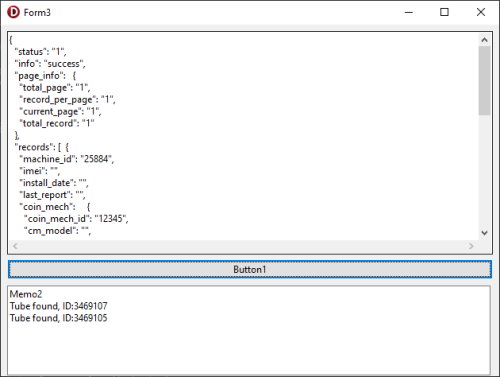-
Content Count
1090 -
Joined
-
Last visited
-
Days Won
23
Posts posted by aehimself
-
-
Isn’t the dropdown menu a TPopupMenu? Or you mean in this scenario the property is not populated?
-
Not sure if it will work here but you can try to check the TPopupMenu.PopupComponent property.
-
Zeos recently implemented a Proxy driver which does exactly what you describe - it only exposes the proxy and client apps “connect” to this proxy. It supports all protocols which Zeos itself supports.
I personally never tried it so I cannot say anything about security and such, but you can give it a try.
-
 1
1
-
-
42 minutes ago, Keesver said:This is a clustermess. If you are publishing to Android you must have an update subscription so you can continue to be present; but even if you do you’ll do it on a beta platform which might not produce fully functioning code…? Am I getting it right…?
Fortunately I’m not affected it; it just sounds extremely strange. I did not check the article but I’m sure the steps needed could be automatized and depleted via a patch.
-
Is this shortcut to the exe what Delphi compiles?
Windows Explorer caches the icon of executables and shortcuts so you might need to clear that cache for you to see the icon you just set.
-
 1
1
-
-
According to the stack trace it is indeed GDI object exhaustion. Check where and how you are manipulating images and make sure you are disposing of them properly.
We had this when there was an image list on a frame which was created thousands of times. Moving the imagelist to a common place solved our issue immediately.
@Dalija Prasnikar we also received EOutOfResources when our application used up all available user handles so it’s not strictly GDI-related. But yes, leaking handles often pop up as Delphi classes in the memory leak report.
-
Yes, it should be ListView1.Items.Add.
If you declared your class like I posted (descending from “nothing” = TObject) it does not require an owner (not a parent).
If the definition is correct, it’s still possible that the RTL has a component named TListItemData, so you can try to name yours “TMyListItemData” or something else - that will help the compiler to recognize which one you want to create and what parameters it requires.
-
What OS the application is running on? Also, are you reusing your threads or creating and freeing them up as needed?
On Windows 2000 creating and freeing up threads lead to the same error for me (probably due to memory fragmentation, idk) and the solution was to simply reuse threads.
-
It's not working with a global variable because you cannot make sure that it has the right value the moment the ListItem (re)draws an item (e.g. during scrolling). Instead, you have to tie this data to each independent node. Declare a type, e.g.:
TListItemData = Class public BoldText: Boolean; End;
Then, when adding a list item:
var li := ListItem1.Items.Add; li.Data := TListItemData.Create; (li.Data As TListItemData).BoldText := True;
To make sure you are not leaking memory, add an OnDeletion handler to your ListView:
If Assigned(Item) Then Begin TListItemData(Item.Data).Free; Item.Data := nil; End;
After all this, in your custom draw methods you can check the object's property:
If Assigned(Item.Data) And (Item.Data As TListItemData).BoldText Then Sender.Canvas.Font.Style := [fsBold] Else Sender.Canvas.Font.Style := [];
I did not run this code so some minor adjustments might be needed but the basics are this.
Also, instead of a custom class you simply can create and assign a PBoolean to Node.Data, but a class is more versatile if you want to add more properties later on.
-
When you open the site in your browser you can check all the network calls made for the site to actually load. If you are lucky there will be an API call which returns the file list in a well-known format.
Even if there is one, I don’t know however if you are allowed to query that API… the site owner will be able to tell you the legal parts.
-
 1
1
-
-
In your browser it works because there are some JavaScript generating / fetching the data from somewhere else with your browser happily renders.
You’ll need TEdgeBrowser or something similar to actually render it for you and then process the visible document.
-
 1
1
-
-
I wonder where @RRUZ got this unit. IF we are talking about the same component, according to it, TEditControl has two published properties:
property CaretX: SmallInt; property CaretY: Integer;
If we can find out how to access this type from a Delphi application (even without source) I'm sure TEditControl could be accessed via it's handle and some pointer magic...
-
 1
1
-
-
That's a pity. Unfortunately the source of TEditControl and TCustomEditControl is buried somewhere so we can not be sure what it can do, what it will reply to.
Worths a try though, maybe...
-
34 minutes ago, Attila Kovacs said:chatGPT
And here I thought the chatgpt hype died down already. Got proven wrong yet again 🙂
-
 1
1
-
-
Stupid question… can we integrate SpamAssassin or a similar (automatic) content checking to trigger flagging posts (posters) as spam?
-
To open a file you can use DDE, which @Attila Kovacs got working some time ago:
As for repositioning, you can try to get the handle of the editor control and send a EM_SETSEL message.
That would be my approach, that is.-
 1
1
-
-
1 minute ago, Stano said:I have: amTranslationManagerInstall-2.0.8370.39904 - year 2019
So I went through it. I have understood/figured out where and how to get to the filters. How the filters and Find work.
I searched for pumAutoIns from:LocNavigator unit;
resourcestring
pumAutoIns = 'Automatically insert the next record';Unfortunately, it's not there

Resource strings are prefixed with the unit name they are in; so it should be named LocNavigator_pumAutoIns
It must be there. Never met any resource string left out by BTM.
-
Including the checks if a specific branch exists or not, you also can use the built-in System.Json unit:
Var jo, coinmech: TJSONObject; recenum, tubeenum: TJSONValue; records, tubes: TJSONArray; begin jo := TJSONObject(TJSONObject.ParseJSONValue(Memo1.Text)); If Not Assigned(jo) Then Exit; Try records := jo.GetValue<TJSONArray>('records'); If Not Assigned(records) Then Exit; For recenum In records Do Begin coinmech := recenum.GetValue<TJSONObject>('coin_mech'); If Not Assigned(coinmech) Then Continue; tubes := coinmech.GetValue<TJSONArray>('tubes'); If Not Assigned(tubes) Then Continue; For tubeenum In tubes Do Begin WriteLn('Tube found, ID:' + tubeenum.GetValue<String>('tube_id')); // ... // Add a new record in a MemTable...? End; End; Finally FreeAndNil(jo); End;
The code can be siplified significantly but this way you can see what is happening, how TJSONObject handling works. The code above produced the following output:
-
-
While it works, storing and using data in the UI is never a good idea. If one day you want to change the ListBox to something else you’ll have to rewrite the whole logic.
I’d suggest parsing (deserializing) the JSON into your custom class, filling the ListBox and extracting the ID from there when needed.
-
Short answer: never.
Long answer: there are always code breaking changes in code or in protocols which will make older applications to be unable to communicate with never versions.
This is why - if you really can not upgrade - we are using virtual machines with legacy OS-es hosting legacy applications.
As ESXi is free you can also have your “museum” built this way but be aware that these legacy systems are usually extremely vulnerable to attacks in todays world.
-
 1
1
-
-
I am using DCPCrypt in 64 bit applications without any issues but I remember that I had to dig for a package as there was one which didn’t compile.
I’ll check later today which version I’m using and where exactly I downloaded it from.
Edit: ReadMe simply say I'm too using v2 but I cannot find any reference to the sub version number. I still need to confirm this somehow but I think I'm using the SourceForge version.
Do you have a code snipplet which fails to compile or it's the package itself?
Edit-edit: my archive which has the source is called "dcpcrypt-code-r16-trunk.zip". So I'm pretty sure it's the SourceForge version 🙂
-
18 hours ago, TazKy said:I put the blame on DevExpress because I dislike the whole product and perhaps too quickly laid the blame on it.
Thats very subjective, isn’t it? 🙂
DevExpress indeed slows down Delphi - which is perfectly normal as it adds hundreds of components to the palette. But in my experience this only affects the load time of the IDE itself, not the appearance of your first form / unit on the screen!
Which one you have an issue with?
-
Use TJsonValue.AsString instead of .ToString and your values will be properly converted and dequoted.
![Delphi-PRAXiS [en]](https://en.delphipraxis.net/uploads/monthly_2018_12/logo.png.be76d93fcd709295cb24de51900e5888.png)



TButtonEdit and left button dropdown menu
in VCL
Posted
I see. Thank you for confirming.